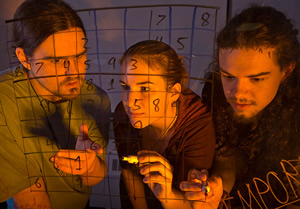Team deemed 'outstanding' at national competition
Team deemed ’outstanding’ at national competition
Submitted by Megan Otts
Phone: 907-474-6959
05/05/08

A trio of students from the University of Alaska Fairbanks recently took top honors in a field of international competitors and Ivy League powerhouses in the 2008 Mathematical Contest in Modeling.
The team earned the annual competition’s highest designation--outstanding--finishing in the top nine out of 1,162 teams. The team also won the INFORMS prize for its work developing an algorithm to generate Sudoku puzzles of varying difficulty.
The team’s top finish was lucky number seven for UAF and the first in nearly a decade. UAF teams have been awarded the "outstanding" designator six previous times--in 1990, 1991, 1993, 1995, 1997 and 1999.
The Consortium for Mathematics and Its Applications, a nonprofit organization that seeks to improve math education for all students, hosts the contest. Participants have 96 hours to research one of two modeling problems, develop a solution and submit a formal paper summarizing their findings. Teams are allowed to use reference materials, but cannot solicit input from anyone outside of the team, including their advisers.
UAF’s team got off to a rough start this year, according to team member Seth Chadwick, a senior in computer science. They couldn’t access the problems due to the rush of teams accessing the Web site.
"The problems were posted online on Thursday," he said, "and at that point there were lots and lots of people refreshing that page over and over again so we had no idea what [the problems] were going to be."
Once they saw the options, the team had little difficulty choosing one. Chadwick had spent part of his Christmas break creating a Sudoku generator in PHP programming language. His confidence in his ability to solve the problem was all the team needed to make its decision.
They spent most of the next four days holed up in a Chapman Building conference room, consumed with the 9-by-9 grid logic puzzles. While some teams choose to work through the night, team member Christopher Granade, a senior triple-major in physics/computer science/math, said he and his partners decided they would do better work if they were well rested each morning.
"We made the conscious decision early on that we wouldn’t do so well if we tried to pull an all-nighter," he said. "There are some teams that try that and it works well for them I suppose, but we decided that we wanted to attack the problem fresh each day, so we did go get 6 hours of sleep a night."
Aside from the time they spent sleeping, the group took few breaks and spent more than 16 hours a day concentrating on finding a solution.
Though he couldn’t help them with the problem, team adviser and associate professor Orion Lawlor took on a support role, keeping team members stocked with pizza and Dr. Pepper. His office couch served as a place for catnaps and he made sure the team had the computing resources it needed.
Lawlor has a good idea what it takes to excel in the contest. He was a member of two UAF MCM teams that earned "outstanding" designations in the late 1990s. His main job now is to recruit and organize the teams, which he said involves a bit of strategy.
"Teams have to contain a diverse mix of personalities and skills," Lawlor explained. "The team members have to be smart and hard-working, but they also have to each think about the problem differently--a broad team will ask questions and verify assumptions that a more tightly focused team will not."
He seems to have found a good mix this year.
Rachel Krieg, a junior in mathematics and statistics, used her knowledge to help form equations, analyze puzzle solutions and graph data. Chadwick took control of the computer coding, creating a puzzle-generating algorithm and programming it to produce puzzles of varying difficulty. Granade used his broad understanding of the concepts to bring together the information and organize the team’s 62-page paper.
"[Granade] is CS and math, and so he knew what [Chadwick] was doing, kind of, and knew what I was doing, kind of, so he was able to bring it together and make it make sense in the paper," she said.
After three long days of work, the group had time to polish their paper, finishing with 45 minutes to spare. The paper will be published in the fall 2008 COMAP Journal.
"We are going to be published in a mathematical journal, which is huge for us as undergraduates," Krieg said.
A number of factors contributed to the team’s success, Lawlor said. "They’re smart people who happened to know a little about the problem, managed to find a good approach for solving it and worked incredibly hard to make their approach pan out."


